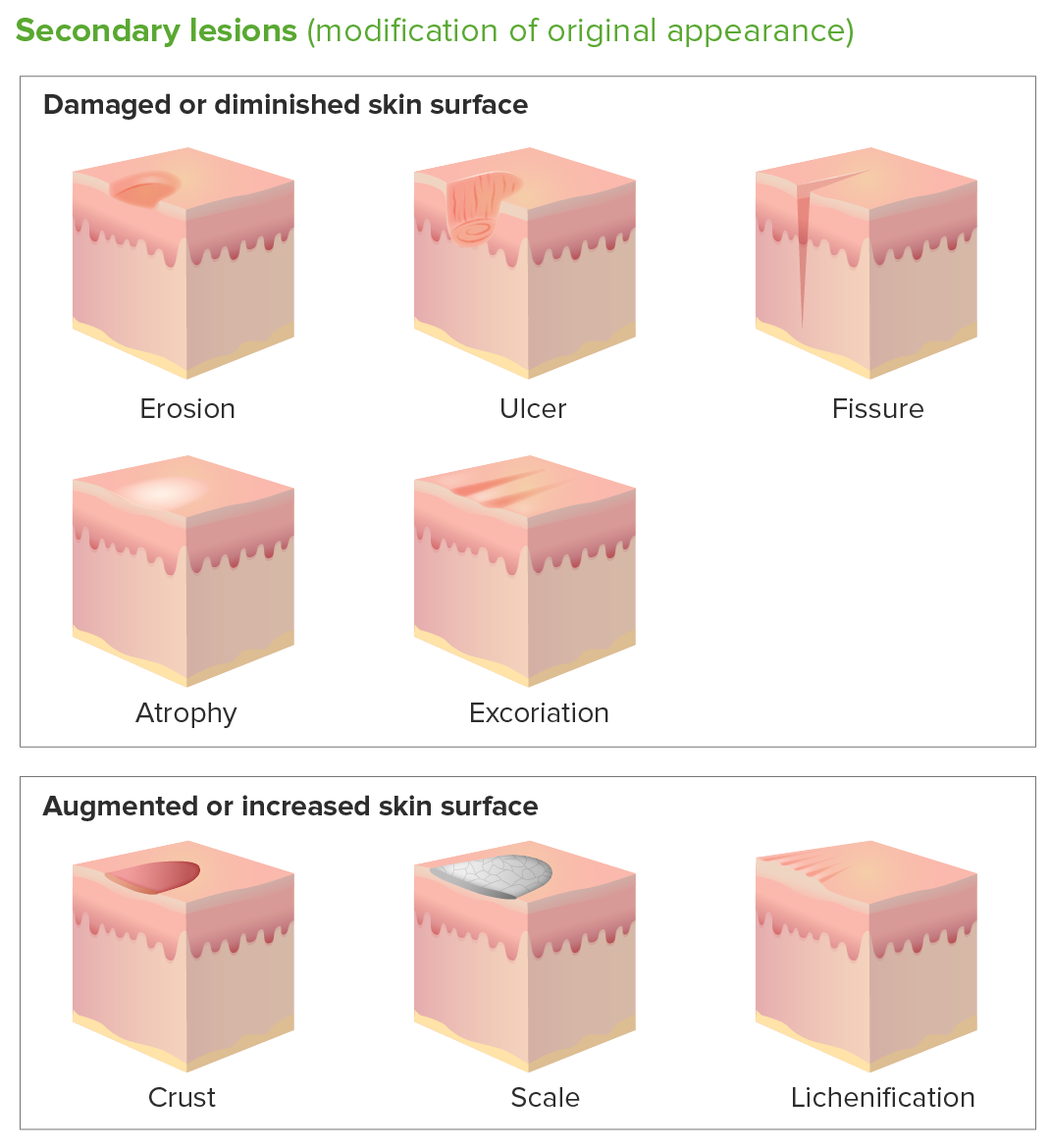Playlist
Show Playlist
Hide Playlist
Diagnostics in Dermatology: Skin, Nail, and Hair Specimens
-
Slides Diagnostics in Dermatology Skin Nail Hair Specimens.pdf
-
Download Lecture Overview
00:01 Welcome to our lecture. 00:02 We will be talking about some of the essential diagnostic tests that we do in dermatology. Firstly there's microbiological tests, histopathology blood tests, allergy tests and imaging and imaging includes wood lights examination dermoscopy as well. 00:24 So now we're going to talk about some of the microbiology investigations that we do in dermatology. The first one is skin swabs. 00:34 We use this for bacterial, fungal and viral infections. 00:39 We normally use standard swab which is a cotton tip on a plastic shaft. 00:46 Now let's illustrate how we take the parcel up. 00:51 Firstly you have to clean and disinfect the surface with saline or a normal verb called swab. If blisters are present, you may consider puncturing the blister and removing its roof, especially in the case of virally induced blisters. 01:11 You rub the swab gently and firmly over the affected area, then place the swab into the transport medium and send it to the laboratory for microscopy, Culture and Sensitivity. Now the lab technicians will look at the swab and do the following. 01:33 With bacterial investigations, you need to do a bacterial culture. 01:39 So that means taking the swab that you have collected from the patient. 01:44 And then you rub it on the agar medium to see which bacteria grows. 01:51 We also look at the sensitivity remember microscopy culture and sensitivity. 01:58 And then this helps us to determine which antibiotic will the bacteria be sensitive to so that when we have to treat the patient we know whether there's resistance or not. 02:10 We also do what we call a gram stain to see which color does the bacteria stains. 02:19 Moving on to viral investigations. 02:23 This is a viral cell culture, and we also do PCR to try and identify the specific serotype of the virus. 02:34 Swabs can also be used in the diagnostic process of fungal infections. 02:39 We are now going to talk about skin scraping, which we use for skin fungal infections. When one suspect a fungal infection on the skin, you have to remove any traces of skin products or medication using the alcohol swab. 02:57 Try and choose the best area to scrape because you always looking for the active area to ensure that you are able to pick up the the viable fungus do on your patient. 03:09 Because when they see you carrying the scalpel, they think going to cut them. 03:12 Do warn them that you just want to scrape the lesion. 03:15 In fact, they enjoy it because it's a nice scratching, because tinea pedis is very, very itchy. So scrape the skin using a scalpel held at a blunt edge. 03:27 Collect scrapings onto a piece of paper or glass and send the scrapings to the laboratory for further investigation. 03:35 The more skin scales you have, the better yield. 03:39 Is the technician going to pick up in the lab for nail fungal infection, or what we call onychomycosis, something that we'll talk about in our other lectures. 03:51 We also use nail clipping to look for the fungus. 03:58 So again here you clean the nail with an alcohol swab and take the sample from the discolored or brittle part of the nail, the proximal. 04:07 You know what I normally say to the students when I teach them is that when you hear the sign, when the when it's painful for the patient, you've got the right area, because that's where the fungus is sitting at the junction of the normal and the Brooklyn nail. 04:23 Clipping is done using a clipper. 04:26 Cut back as far as possible from the free edge as you can, and you will be able to find the fungus in those areas. 04:36 The minimum specimen size of a nail is three millimeters, and the optimal size is about six millimeters or more. 04:42 So after clipping, also scrape underneath the nail and collect all that debris. 04:48 We want the debris because that's where the fungus is sitting. 04:52 You then send your nail clippings, just like you did with the skin scrapings, and send them to the laboratory for further investigation. 04:59 What about tinea capitis? Again, we're looking for fungus here, so there's two ways of doing this. 05:05 One, you can either use a swab like you did with bacterial infection, or you can use tweezers to pluck the hair from the affected area. 05:13 Again, you go for the edge of the lesion because the fungus spreads from the center and peripherally. 05:20 So you want to hit it where the fungus is still active. 05:24 And you also try and scrape the affected area of the skin. 05:29 A Wood's lamp actually can be a good guide for the collection of the samples. 05:43 You send all the collected samples to the laboratory for further investigations. 05:48 So what does the lab technician do with the fungal specimens? Remember when I spoke about bacterial infection? I said it's microscopy culture and sensitivity. 05:59 So they look at it under the microscope. 06:01 So the sample is treated with potassium hydroxide which is coach and examined under the microscope. The potassium hydroxide helps to dissolve the keratin so that we can see the fungus clearly. 06:16 And this can also be sent for fungal culture. 06:19 We again use the specific medium to see which fungus will grow. 06:24 And when you see a white growth, then the microbiologist will be able to tell us what it is or the microbiologists.
About the Lecture
The lecture Diagnostics in Dermatology: Skin, Nail, and Hair Specimens by Ncoza Dlova is from the course Introduction to Dermatology.
Included Quiz Questions
What part of a rash should be sampled to detect for an active fungal infection?
- The leading edge
- The center of the rash
- The unaffected skin surrounding the rash
- The scaly surface of the rash
- The area with the least visible inflammation
What is the best way to sample hair specimens?
- Use tweezers to pluck hairs from the affected area.
- Shave the affected area and collect the clippings.
- Cut the hair close to the scalp with scissors.
- Brush the hair and collect the loose strands.
- Use a cotton swab to rub the affected area.
Which of the following methods correctly describes the proper technique for collecting a nail clip sample?
- Take the sample from the discolored or brittle part of the nail.
- Clip the nail from the healthy, clear part only.
- Soak the nail in water before taking the sample.
- Take a sample from the nail bed, avoiding the nail itself.
- File the nail down and collect the dust for the sample.
Customer reviews
5,0 of 5 stars
| 5 Stars |
|
5 |
| 4 Stars |
|
0 |
| 3 Stars |
|
0 |
| 2 Stars |
|
0 |
| 1 Star |
|
0 |




